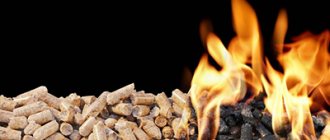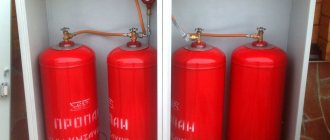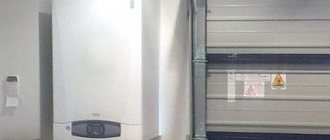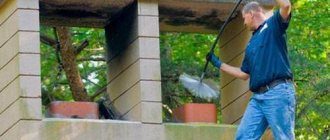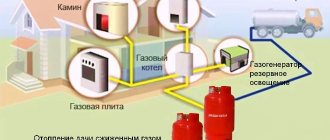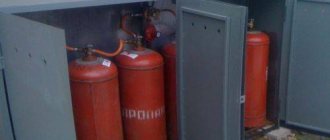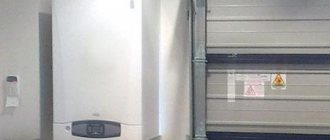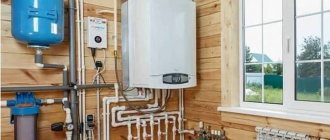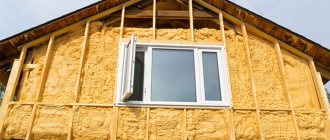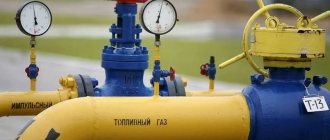Pellet heating is a modified, high-tech installation that allows fully automated operation of boiler equipment. This cannot be achieved when using coal and firewood. Pellet heating boilers have 3 main components:
- boiler with burner;
- storage tank;
- fuel supply mechanism.
What is a pellet boiler?
One of the main disadvantages of long-burning wood boilers is the fuel itself, it is bulky and requires a lot of storage space.
Classic solid fuel boilers for heating private houses are designed to burn wood, coal, coke and other solid fuels. To do this, they are equipped with a large firebox in which fuel is burned, releasing a large amount of heat. Such boilers require constant addition of new portions of firewood and coal - they burn out quite quickly, which leads to a gradual cooling of the heating system.
Long-burning solid fuel boilers that have appeared on the market and are used for heating private houses have pleased their owners with a reduced number of approaches for loading fuel - some of them can operate for up to 8-10 hours, depending on the fuel used. This approach allows you to count on long-term and uninterrupted operation - you can be sure that the rooms will not get cold by morning.
An alternative to long-burning boilers are pellet boilers that operate on special combustible granules - pellets. This fuel releases a large amount of thermal energy and has many advantages over wood and coal:
- Affordable cost - due to the fact that pellets are a product created from various wastes, their cost is in a very affordable range;
- Convenient storage - just fold the bags of granules in any convenient place. You can also provide a spacious bunker for this;
- Convenient dosage - pellets are a free-flowing and very light combustible material, so they can be dosed with an accuracy of a few grams. It is also very convenient to fill them in - you can use a deep spatula for this.
A pellet boiler for heating a home is a rather impressive unit that runs on pellet pellets. Fuel is stored in a bunker, the dimensions of which can be either small or very large. Pellet fuel gradually enters the combustion chamber, where it burns, releasing a large amount of heat. The heat is then absorbed by the heat exchanger.
The temperature difference between the combustion chamber and the heat exchanger outlet is very large - the combustion products cool here from a temperature of 800-900 degrees to 100-120 degrees.
Pellet boilers for home use consist of the following components:
- Bunker – pellet fuel is stored here and taken into the combustion chamber. Some models of pellet boilers have very large hoppers, which allows you to count on the longest warm-up and continuous heating of a private home for several days in a row;
- Auger – ensures a smooth flow of pellets into the working chamber; it is driven by an electric motor;
- Combustion chamber – this is where the combustion process takes place;
The main units and components of the pellet plant.
- Burner – in this module the pellets ignite and burn. We can say that the combustion chamber and the burner are one and the same unit;
- Heat exchanger – this is where heat is transferred to the heating system. Heat exchangers can be very different, ranging from flat steel to multi-pass cast iron;
- Control module – controls the fuel supply to the furnace, checks operating parameters, and monitors safety.
Pellet boilers used for heating private houses also contain many other components - ash collectors, safety valves, ignition systems and much more. But the main ones are the above modules - they are responsible for creating heat and transferring it to the heating system of a private home.
Thanks to the automatic supply of fuel, pellet boilers do not require frequent approaches. One download is enough for several hours, or even several days. Moreover, the most advanced models independently maintain the temperature in the system, regulating the supply of pellets and the combustion of the flame - for this they are equipped with multifunctional automation systems.
Additional settings
When the main parameters are set, you can move on to the auxiliary ones.
The first option is that you can adjust the ignition time of the pellets. By default it is 5 minutes. This is exactly how long the special halogen lamp is turned on, which is responsible for igniting solid fuel.
High quality pellets ignite faster - in 3-4 minutes, and in this case the ignition time can be reduced. In the case of inexpensive fuel, it is recommended to increase the parameter to 6-7 minutes.
Also, installing a pellet burner in a solid fuel boiler necessarily involves setting such indicators as:
- burn-out time (characterizes the maximum fan power after stopping the fuel supply);
- coolant temperature “return” (once it is reached, the burner changes the “Heating” mode to “Maintenance” - it is set to approximately 60 ° C);
- supply coolant temperature (critical value within 90-95° - at this temperature the supply of pellets stops, and an “Overheating” warning signal appears on the control panel display);
- auger control (two modes - “On” and “Off” - when activated, pellets are smoothly fed into the combustion chamber).
If the burner operation must be stopped, under no circumstances should the plug be pulled out. Such a sudden disconnection from the power supply will provoke a pressure surge inside the system, which will lead to the fan stopping, which, in turn, will provoke the release of soot and ash onto the internal elements of the boiler and extinguishing the pellets. Next time the fuel will ignite noticeably worse.
APG-25 will pause operation if you press the red “Stop” button on the control panel twice. Pressing once will enter the system into pellet burning mode.
Correct setting of a pellet boiler is the key to its smooth operation.
How to calculate pellet consumption
Considering the fact that fuel is supplied in bulk or packaged in bags, it is, in principle, not difficult to calculate the consumption of pellets per 1 kW or per 1 m2. There is no need to convert weight units into volume, since delivery always occurs in kilograms, and the heat of combustion of fuel is also measured in kW per 1 kg of weight.
Good quality granules have excellent calorific value; burning 1 kg of such fuel produces almost 5 kW of thermal energy. Accordingly, to get 1 kW of heat for heating a house, you need to burn about 200 grams of pellets. The average consumption of granules per unit area can be easily determined based on the fact that heating each 1 m2 of area requires 100 W of energy
One condition is important: the ceiling height should be within 2.8-3 m. 100 W of heat will be obtained from 20 grams of granules, it would seem simple arithmetic. But it was not there
The figures presented above are correct if the pellet boiler has absolute efficiency - 100% efficiency, but this does not happen in real life. In fact, the efficiency of such heat generators, although higher than that of solid fuel boilers, is still only 85%. This means that after burning 1 kg of pellets in the furnace of the unit, not 5 kW of energy will be obtained, but 5 x 0.85 = 4.25 kW. Conversely, to release 1 kW of heat in pellet boilers, 1 / 4.25 = 0.235 kg or 235 grams of fuel is consumed. This is the first nuance
But it was not there. The figures presented above are correct if the pellet boiler has absolute efficiency - 100% efficiency, but this does not happen in real life. In fact, the efficiency of such heat generators, although higher than that of solid fuel boilers, is still only 85%. This means that after burning 1 kg of pellets in the furnace of the unit, not 5 kW of energy will be obtained, but 5 x 0.85 = 4.25 kW. Conversely, to release 1 kW of heat in pellet boilers, 1 / 4.25 = 0.235 kg or 235 grams of fuel is consumed. This is the first point.
The second nuance is that 100 W of heat per 1 m2 of room is required when the ambient temperature is the lowest, which lasts for 5 days. On average, during the heating season, thermal energy consumption is half as much. This means that the specific heat transfer per unit area is only 50 W. Determining the consumption of pellets in a pellet boiler for 1 hour relative to 1 m2 will be incorrect; the figure will be small and inconvenient. It would be more correct to calculate the weight of pellets burned per day.
Since Watt is a unit of power per 1 hour, then per day for each square of the room you will need 50 W x 24 hours = 1200 W or 1.2 kW. For this purpose, you will need to burn the following mass of pellets per day:
1.2 kW / 4.25 kW/kg = 0.28 kg or 280 grams.
Knowing the specific fuel consumption, we can finally obtain values useful for financial calculations, for example, the average seasonal weight of pellets used per day and per month in a house with an area of 100 m2:
- per day - 0.28 x 100 = 28 kg;
- per month – 28 x 30 = 840 kg.
It turns out that 8.4 kg of fuel is needed per month to heat 1 m2 of a building. At the same time, according to user reviews on various forums, heating a well-insulated house of 100 m2, located in the middle zone, takes about 550 kg of pellets, which in terms of square footage is 5.5 kg/m2. This means that the consumption of pellets in the boiler in the amount of 840 kg per month for a building of 100 m2 is very large and suitable for calculations of poorly insulated houses.
Let us summarize some results in the form of calculation results for dwellings of various sizes. The following are the monthly costs of pellets for heating a private home:
- 100 m2 – 840 kg with poor insulation, 550 kg for good thermal insulation;
- 150 m2 – 1260 kg and 825 kg, respectively;
- 200 m2 - 1680 kg and 1100 kg under the same conditions.
For reference. In many boiler installations, the controller has a function that allows you to see on the display the consumption of pellets in kilograms over a certain period.
Construction of pellet boilers
Pellets are solid fuel that is produced from wood waste, peat and agricultural waste. In fact, these are pressed pellets of small diameter, up to 5 cm in length. The main advantage of pellets over other types of solid fuel is their low ash content; therefore, the need to remove soot arises less often than when using firewood
If the impact on the environment is important to the home owner, then pellets cause minimal harm to the environment. Operating principles of a pellet boiler - pellets are loaded into a hopper, then they are fed into the firebox, where they burn, releasing heat. The most important thing is that all processes are controlled by automation
Those. if you need to quickly warm up the house before guests arrive, a pellet boiler will burn fuel at maximum speed, feeding pellets into the firebox using an auger. As soon as the required temperature is reached, the equipment will switch to temperature maintenance mode, reducing the fuel supply rate
The most important thing is that all processes are controlled automatically. Those
if you need to quickly warm up the house before guests arrive, a pellet boiler will burn fuel at maximum speed, feeding pellets into the firebox using an auger. As soon as the required temperature is reached, the equipment will switch to temperature maintenance mode, reducing the fuel supply rate.
Burners in pellet boilers are divided into two types - retort and flare. A retort burner is a bowl with slots into which pellets fall and ignite under the influence of hot air. In torch-type burners, pellets are fed to a platform where hot air creates a torch directed horizontally. There are no clear advantages for any type of burner, so when choosing specific equipment it is not a decisive factor.
Flare-type burners are used in the Metal-Fach Smart BIO line. Smart BIO is the company’s own development; the burner is made in the form of a trench. Designed for burning pellets and grain. The design of the firebox allows the use of coal and firewood.
Most pellet boilers are equipped with an automatic ignition system. The absence of such a function means that the process must be started manually each time, which significantly reduces ease of use. If there is automatic ignition, the boiler can start heating the house on its own using a timer, sensor or command from a mobile phone.
The Metal-Fach SEG BIO model allows you to light a fire from anywhere on the planet by simply sending the appropriate command from your phone or via the Internet. In emergency cases, wood or coal can be used as fuel, but pellets are preferable.
Metal-Fach SD DUO BIO is designed for minimal environmental impact - it is designed for the use of pellets. It can also work on eco-seed coal, wheat grains, and grape seeds. The equipment is automated - there is automatic feeding, automatic ignition, and can be controlled from a cell phone and via the Internet. In addition, boilers of the SD DUO series have a water-filled grate, which increases heat removal. It is worth noting that SD DUO boilers are the flagship in the line of boilers of the Polish company Metal-Fach.
Algorithm for calculating coal consumption
A modern type boiler can operate effectively on both hard coal and brown coal. But if you have a choice, it is better to choose high quality coal - anthracite. It is characterized by the highest thermal capacity and burns almost without a residue. However, the cost of anthracite is higher than other varieties. It is necessary to consider the price of fuel, delivery and its heat capacity, and choose the best option.
There are two ways to calculate coal consumption in a solid fuel boiler. The very first one is elementary, using a bucket. Coal is usually measured in tons, but it is unlikely that your boiler room will have scales to accurately weigh out the required dose for loading.
Approximately, to heat a 200 m² home the following amount of angle will be required:
- In September-October, one bucket per day.
- From November to February - 10 buckets.
- In March-April there are about two buckets.
If you assume that there are 30 days in a month and add up all the values, you can find out the total number of buckets (780 buckets). In kilograms it turns out:
780 x 18 = 14040 kg
Thus, during the heating season, a coal boiler will consume a little more than 14 tons of coal to heat a 200 m² home.
The second method of calculating coal consumption in a solid fuel boiler is more scientific. Combustion of 200 g of coal will require about 1 kW of heat. For comfortable living during the heating season, approximately 50,000 kW of heat is required:
50000 x 0.2 = 10000 kg (10 tons)
Factors influencing the level of solid fuel consumption
It is not difficult to calculate how much a solid fuel heating boiler consumes. It is more difficult to correctly select the initial data to perform calculations.
The following presents the calculation method and at the same time provides a calculation of the consumption of the amount of firewood to heat a home of 100 m². However, first let's look at the source data:
- the type of wood that is selected for kindling;
- wood moisture level;
- efficiency factor of a solid fuel stove or boiler;
- thermal power required to heat the room.
If you've ever used a stove, you're probably aware that when wood burns, different types of wood produce different amounts of heat. Let's say birch logs emit more heat than poplar or pine. This is due to the difference in density and thermal output of tree species. In addition, the volume of firewood per 1 kW of heat energy depends on the moisture content in it. Accordingly, the higher the humidity, the more heat is spent on evaporating liquid from the firewood, and less is left for heating the home. As a result, more fuel will be needed to heat the house.
How rationally the energy contained in the fuel will be used depends on the efficiency of a particular heat source. Let’s say a fireplace or stove releases most of its energy into the atmosphere along with combustion products, so their heat transfer reaches only 60%. At the same time, a solid fuel or pyrolysis (long-burning) boiler operates with a heat output of 80%. These nuances should be taken into account when calculating the cost of heating a home.
It is better to take the value of the thermal power required to heat the house according to the calculation made by the craftsmen during the design of the home. However, often such data is not stored by property owners. Therefore, the amount of firewood and its cost can be determined by the average value of power consumption. It is determined in a standard way: heating 10 m² requires 1 kW of heat under the worst conditions, and the average for the season is 0.5 kW. The average figure for a dwelling with an area of 100 m² will be 5 kW/h.
Heating a private house with pellets - pros and cons
A solid fuel pellet boiler for a home with automatic fuel supply, like any other heating option, has both its advantages and disadvantages. Consideration of the pros and cons helps to make the most reasonable decision regarding the advisability of equipping a boiler room with wood pellet equipment.
The disadvantages are the following:
- Dependence on pellets – a few years ago, good quality pellets were difficult to obtain, which significantly affected the cost of fuel. Today, purchasing pellets of plant or wood origin is not difficult. Refilling a pellet boiler lasts for several hours, days or even months, depending on the chosen model. The user is required to calculate the operating time and purchase the necessary fuel in advance.
- High installation cost. Another disadvantage pointed out by opponents of pellet equipment is its high cost and expensive repairs. Today, the price of equipment is gradually declining due to high market saturation.
The reasons for purchasing pellet equipment are:
- Economical - fuel costs are slightly higher than for a gas boiler, but if you take into account the cost of obtaining permits, the need to prepare design documentation, and pay for gas pipeline installation, the difference becomes not so obvious. Economical pellet boilers for home use less raw materials than convection and gas-generating solid fuel units. Heating costs are also lower compared to an electric boiler.
- Simple installation requirements - the boiler is installed fairly quickly. Combined systems with an integrated fuel tank simply need to be connected to the power supply network and a chimney installed.
- Versatility - most modern models manufactured by domestic manufacturers are capable of using, in addition to pellets, firewood, coal, wood waste, and after replacing the burner, can be converted to use liquid fuel.
- Backup heat sources - an automatic pellet boiler, often has a built-in heating element for heating the coolant. If the solid fuel runs out, the boiler automatically switches to using electricity and continues to heat the house until the pellets are refilled.
Having weighed all the pros and cons of purchasing pellet equipment, many buyers come to the conclusion that it is advisable to purchase a heat generator of this type.
Pros and cons of this type of raw material
Pellets entered the market as a heating product relatively recently, but their popularity is already obvious. And although the prices for equipment that uses them as fuel are not cheap, due to their positive qualities they are becoming more and more popular for heating rooms. Thanks to the variety of their types, you can choose heating equipment according to your needs. If possible, you can choose a boiler with a combustion load for several hours, several days, and even months
In the modern world, more and more attention is paid to the environmental friendliness of the products used. And compressed wood waste becomes an alternative in this case
They are convenient to store; when supplied in bags, they are light and compact in placement. And their quantity is required less than other types of fuel
It is also important that when they burn, the smoke has no odor
The disadvantage of using them, which cannot be avoided, of course, is the release of ash. And even when using elite brands of wood pellets, it is necessary to clean the boiler at least once every two months. And after the winter season, be sure to completely disassemble and clean the boiler. The storage location is also important. And for better performance of their properties, they should be stored in dry rooms without the possibility of getting damp. Since raw ones can cause the boiler to stop working.
Features of pellet boilers
Naturally, the heating is as efficient as possible. eliminating unnecessary fuel consumption, will be carried out by the boiler only if it is operating correctly. You can check the efficiency of boilers of this type in the following way: you need to measure the temperature of the gases leaving the boiler. A temperature in the range of 120-150 degrees indicates normal operation of the equipment, while at the same time its increase indicates that the pellet boiler is faulty.
However, cold in the house does not always indicate ineffective operation of the equipment. Often the cause of uncomfortable temperatures is heat loss caused by low thermal insulation of the house or poor quality of pellets.
Many country property owners who heat using pellet boilers ask the question: is it possible to use this type of equipment for other fuels? If the boiler’s function was originally designed by the manufacturer to operate on other solid fuels, if pellets are not available, the boiler can be fueled with wood or small coal. But at the same time, the main advantage that a pellet boiler has is lost - its autonomy.
Having considered the advantages of equipment operating on pellets, one cannot help but mention its disadvantages. First of all, this is the need for regular cleaning of the boiler from ash, which should be carried out at least 2-3 times a month. This is a rather “dirty” procedure, often requiring the presence of male hands. Today, boilers with a self-cleaning function have appeared on the market, but their price is quite high. This makes their purchase impractical for heating a small country house.
DIY pellets
Let’s say right away that this is a rather complicated procedure that can only be handled if you have all the necessary equipment.
Stage one. Preparation
Here is a list of required equipment:
- crusher (if the raw material is wood, sawdust or husk); the device is optional, since if desired, you can purchase ready-made crushed raw materials;
- granulator, matrix for it (cylindrical or flat);
- an aerodynamic or drum type dryer - it can be made from an iron barrel;
- secondary crusher.
Note! It is advisable to use a flat granulator, since it is quite easy to make it yourself, and no expensive elements are required in this case. In addition, with a flat granulator, crushers are not needed, since the crushing process will take place in it
And the need for a dryer depends on the percentage of moisture in the feedstock. By the way, a granulator can be made at home - now you will find out how!
In addition, with a flat granulator, crushers are not needed, since the crushing process will take place in it. And the need for a dryer depends on the percentage of moisture in the feedstock. By the way, a granulator can be made at home - now you will find out how!
Video - How to make a granulator
Stage two. Procurement of raw materials
- The raw material should not contain any foreign impurities; therefore, it must be sifted before starting work, otherwise the finished pellets for heating will be of poor quality.
- The maximum moisture content of this raw material is only 12 percent. For this reason, all materials are pre-dried.
- It is desirable that the raw materials contain a lot of glue, lignins and resins. This will speed up the granulation process, and the final material will hold its shape perfectly.
- A special drying drum must be used to dry the raw materials.
Further actions can unfold according to several different scenarios - it all depends on the type of feedstock.
Option #1. Making pellets from sawdust
If the granules are made from sawdust, then the algorithm of actions should be as follows.
Stage 1
. The sawdust is dried to a minimum moisture content - which, remember, is 12 percent.
Stage 3
. The sawdust is then crushed by a hammer mill.
Stage 4
. If after this the moisture content of the material is below 8 percent, then it is treated with hot steam to increase this indicator.
Stage 5
. The raw materials are pressed and the pellets are given the required shape.
Stage 6
. After this, they are dried and cooled.
Stage 7
. Finally, they are packed into paper bags for storage.
Option #2. Making pellets from straw
Let’s immediately say that the ash content of such granules is quite high, but so is their energy efficiency. Production requires special equipment. It is difficult to do it yourself, since crushing the straw requires a large crusher. For this reason, it is first necessary to make or purchase the appropriate equipment.
Note! Reed granules are practically no different from straw granules. The equipment in this case is the same
These pellets can be used to heat fireplaces and stoves. But cleaning will have to be done quite often due to the high ash content, but the amount of heat generated is very large, therefore, such fuel has excellent efficiency.
Option #3. DIY peat pellets
The algorithm of actions in this case is as follows.
Stage 1
. The peat dries naturally.
Stage 2
. It is cleaned of impurities, stones and plant residues.
Stage 3
. The resulting mass is crushed.
Stage 4
. The raw materials are dried and brought to a moisture content of 12 percent.
Stage 5
. The peat is re-ground.
Stage 7
. At the end, the granules are cooled, acquire the required strength, after which they can be used.
It is worth noting that such heating pellets can be used not only for heating, but also, for example, to enhance the effect of min. fertilizers in the manufacture of absorbents. Also, with the help of peat granules, oil spilled into water is neutralized.
Video – Pellet production cycle
As a result, we note that pellet heating is becoming more and more popular every year. And it’s not surprising, because the characteristics of pellets are much better than those of firewood or coal. That's all, have a warm winter!
Type
Criteria for choosing the power of a pellet boiler
How to calculate the power of a pellet boiler? The criteria are as follows:
- Room area. Power is taken at the rate of 1 kW per 10 m2. Household models start from 15 kW. We recommend taking 20% as reserve.
- Efficiency of a pellet boiler. It ranges from 85% to 95%. With the same power indicators, we choose the one whose efficiency is higher.
- The use of alternative fuels will reduce power by 20-40%.
- Using raw pellets will result in a loss of another 25-35% of power.
Heated area
Room area is the main criterion for choosing a boiler. Temperatures in winter can drop well below average. The costs of additional insulation can significantly exceed the cost of purchasing a more powerful modification of the boiler and cause a lot of household troubles.
Wall material
Different materials have different thermal conductivities. The lower the thermal conductivity of the wall, the less heat loss. For the calculation, you can take the thermal conductivity coefficients from SNiP 23-02-2003 and from SP 50.13330.2012.
The material changes thermal conductivity under different operating conditions, in particular with increasing humidity. The thermal conductivity coefficient under different operating conditions can be found on the manufacturer’s website.
Let us give the average thermal conductivity of some materials under normal conditions:
- brick - 0.7 W/(m*°C);
- reinforced concrete - 1.92 W/(m*°C);
- pine - 0.14 W/(m*°C);
- foam concrete - 0.28 W/(m*°C);
- oak - 0.18 1.92 W/(m*°C).
Wall thickness
The thickness of the wall is determined by thermal engineering calculations. The calculation process is simplified by special complexes where the user needs to enter initial data. The machine will carry out the calculations and produce the finished result.
Window and door openings increase thermal conductivity. The larger the area of the openings, the higher the heat loss. The use of modern metal-plastic double-glazed windows can partially solve this problem.
Room temperature
Walls are only part of the source of increased thermal conductivity. Heat exchange passes through the floors and roof. The presence of a basement will further increase heat loss. To maximize resource savings, you need to carefully insulate all structures.
The temperature in the room is considered comfortable: +22 - +240 C. Optimal humidity is 60-80%. Supply and exhaust ventilation must be provided to create complete air exchange.
Pellet quality
The quality of fuel plays a decisive role in heating a home. If you use raw pellets, the boiler power will drop by 25-35%. Part of the energy obtained during combustion will be used to dry low-quality pellets
It is extremely important to ensure optimal conditions for fuel storage. First of all, it should be a dry and warm place
Raw materials also play an important role. In the West, this type of fuel has been used for more than a century. The production system and criteria have been developed and standardized at the state level. Our country cannot boast of this.
No uniform quality standards have been developed for this type of product. Each manufacturing enterprise is forced to rely only on its own, unfortunately, not rich experience. There is a high risk of buying low-quality products.
Pellet boilers can operate on almost any type of solid waste. There are models that support different types of fuel. But the efficiency of such boilers is usually much lower.
Other factors
Other factors influencing the choice of a pellet boiler include:
- geographical area;
- average annual precipitation;
- average wind strength and direction;
- conditions and frequency of operation of residential premises;
- type of fuel used;
- quality of materials from which the boiler is made;
- ceiling height;
- price.
It is simply impossible to take into account all factors in the calculation. Their performance can change quite significantly over time. For example, winter may be colder than usual. Or the wind speed, instead of the usual 4-6 points, will be 8 - 9.
What to look for when choosing
When choosing a pellet boiler, I tried to focus on the manufacturer, of which there are many, for example Forumhouse, Pelletron Royal, Valdai, Zota Fox, Biodom and many others. However, over time I realized that characteristics and quality are more important. Reviews from other buyers were also useful, and as a result, I purchased exactly what I needed.
Pay attention to the manufacturer and the declared characteristics of the manufacturer. You need to look at the reviews from the owners of the model you are planning to purchase. It also wouldn’t hurt to read the forum to see what questions arise during operation.
It’s good to look at the rating of that model to determine whether it is included in the list of the best pellet boilers
It also wouldn’t hurt to read the forum to see what questions arise during operation. It is good to look at the rating of that model to determine whether it is included in the list of the best pellet boilers.
The consumption of pellets of the same boiler model may be different due to different operating conditions. This is influenced by certain factors. For example, if you install a boiler that is much more powerful than the characteristics required for your home, then the consumption will be unreasonably high and you will not be able to reduce it in any way. The same will happen if the power characteristics are insufficient.
The most optimal consumption will be if:
- The power percentage is correctly balanced.
- The house will have good insulation of walls, foundation, ceilings, and will have low heat loss.
- The heating system itself is well balanced.
So, photos, reviews from the owner and correspondence on the forum will help you choose pellet boilers. But that's not all. To choose a good boiler, you need to consult both the seller and the specialists who install such equipment. High price does not mean good quality. The goal is to buy a good device at the best price, easy to maintain and an economical option for the pellet boiler system.
Pellet fuel consumption
To correctly assess the heat loss of your home, there are many different methods on the Internet that allow you to calculate fuel costs for heating your home. But the fact is that these methods are based on the use of SNiP and other regulations, however, in practice everything turns out differently. If we take, for example, a room with an area of 130 m2 as a basis, then its heat loss in low temperature conditions often does not exceed 100 W per hour. This indicator primarily depends not on the heating system itself, but solely on the design of the room itself. In order to fully understand the question of which fuel is the most profitable during the heating season, it is better to calculate the consumption of several types of material at once. Having complete information, you can create a special table to obtain data on fuel consumption. Anyone can check whether a pellet boiler is doing its job effectively; to do this, you need to measure the gas temperature at the outlet. The optimal temperature is considered to be in the range of 120-150°C.
Recently, many owners of private houses use pressed pellets made from waste of a wide variety of combustible materials to heat the premises of their homes. These granules are called pellets. Those homeowners who are just planning to install hot water boilers in their home that use pellets as fuel are interested in the consumption rates of this fuel material, as well as the amount of heat released during its combustion. We will try to cover these issues in as much detail as possible within the confines of this short article. As a rule, the choice of one or another type of solid fuel boiler is based on the availability and cost of fuel. In addition, many owners of private houses try to choose equipment that requires minimal maintenance. In other words, there is no need to fill the firebox every day, remove combustion products, etc. Therefore, among a wide range of types of boilers operating on solid fuel, pellet equipment is the most in demand.
Conclusion
Pellet boilers are in growing demand - automated units eliminate the need to regularly load fuel manually. When calculating how many pellets you will need for a heating season, perform the calculation for pellet fuels with different calorific values to find out which of the available options is preferable.
Saving on energy quality results in inefficient fuel combustion, that is, unnecessary financial costs. In addition, heating equipment will fail faster.
Don't forget that improper storage causes wood fuel to accumulate moisture, which reduces its thermal efficiency. When calculating heating costs, be sure to include the cost of energy delivery.
Along with other types of solid fuel, pressed pellets are extremely popular, which are excellent for heating country houses. Since this type of material is very popular, the production of pellets is increasing along with it. Those who have not yet decided to install new equipment in their homes and are thinking about choosing a stove for their home, we recommend reading this article to finally be convinced of the usefulness of pellets. Pellets are considered an excellent, economical fuel, which is usually used as a heating material for country houses. Pellets are granules that are made from straw, sawdust, seed peels, chaff and other organic waste. This material is considered cheaper than, for example, diesel fuel; pellets are very convenient to use and are environmentally friendly.
Fuel quality criteria
As you might guess, in order to release a significant amount of thermal energy, pellets must have the appropriate quality. Unfortunately, given the ever-increasing popularity of this heating method, low-quality fuel samples from unscrupulous manufacturers or outright scammers have begun to appear on the market. Of course, the use of handicraft technologies does not allow achieving effective heat transfer. There is a common misconception among many owners of pellet boilers that fuel consumption depends on the color of the pellets. This is not true at all. High-quality dark-colored pellets are made on the basis of wood fractions, which contain tree bark, light yellow ones are made from waste from the furniture industry, and dark brown pellets are made from logging waste. High quality pellets have a fairly high density, the numerical value of which exceeds 1, so they must sink in water. Also, an important parameter that determines the quality of this type of solid fuel is the amount of ash remaining after complete combustion of the pellets (ash content). According to standards adopted in a number of European countries, this figure should not be more than 1.5%. In other words, after burning 10 kg of fuel, no more than 150 g of ash should remain. If this indicator is higher, a significant amount of slag will be formed during combustion. And this significantly reduces the performance of the boiler.
In addition to the characteristics described above, high quality pellets must have the following characteristics:
- The humidity of the pellets should not be more than 10%, otherwise the consumption of pellets will be significantly increased due to the need to compensate for losses in heat capacity.
- The dust content should not exceed 11%. Exceeding this indicator is accompanied by an increase in ash content.
The packaging must be sealed. The most optimal option is when the granules are sold in special bags with a waterproofing film on the inside. Such packaging allows the granules to maintain their original quality characteristics for many years. Currently, 1 kg of fuel costs from 6 to 10 rubles. If a large-volume bunker is used with the boiler, it is best to purchase fuel in large bags (big bags). The mass of one such bag is 900 kg.
